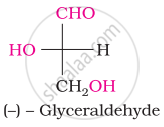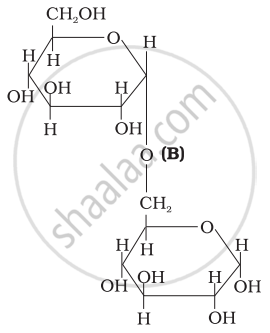Advertisements
Advertisements
प्रश्न
Enumerate the reactions of D-glucose which cannot be explained by its open chain structure.
उत्तर १
(1) Aldehydes give 2, 4-DNP test, Schiff’s test, and react with NaHSO4 to form the hydrogen sulphite addition product. However, glucose does not undergo these reactions.
(2) The pentaacetate of glucose does not react with hydroxylamine. This indicates that a free −CHO group is absent from glucose.
(3) Glucose exists in two crystalline forms − ∝ andβ. The ∝-form (m.p. = 419 K) crystallises from a concentrated solution of glucose at 303 K and the β-form (m.p = 423 K) crystallises from a hot and saturated aqueous solution at 371 K. This behaviour cannot be explained by the open chain structure of glucose.
उत्तर २
D (+) – glucose does not undergo certain characteristic reactions of aldehydes, e.g., glucose does not form NaHSO3 addition product.
Glucose reacts with NH2OH to form an oxime but glucose pentaacetate does not. This implies that the aldehydic group is absent in glucose pentaacetate.
D – (+) – glucose exists in two stereoisomeric forms, i.e., α -glucose and β-glucose.
Both α – D – glucose and β – D – glucose undergo mutarotation in aqueous solution. Although the crystalline forms of α- and β -D (+) – glucose are quite stable in aqueous solution but each form slowly changes into an equilibrium mixture of both.
D (+) – glucose forms two isomeric methyl glucosides. Aldehydes normally react with two moles of methanol per mole of the aldehyde to form an acetal but D (+) – glucose when treated with methanol in presence of dry HCl gas, reacts with only one mole of methanol per mole of glucose to form a mixture of two methyl D – glucosides i. e., methyl – α – D – glucoside (melting point 43 8 K, specific rotation +158°) and methyl – β – D – glucoside (melting point 308 K, specific rotation – 33°).
APPEARS IN
संबंधित प्रश्न
Write the reaction that indicates the presence of -CHO group in glucose
Enlist the properties of glucose that can not be explained on the basis of open chain structure of it
Write the product when D-glucose reacts with conc. HNO3.
Differentiable between the following:
Amylose and Amylopectin
The number of asymmetric carbon atom(s) below the figure is/are


What is the most abundant organic compound on earth?
The symbols D and L represents ____________.
The reaction of glucose with red P + HI is called ____________.
Which of the following reactions of glucose can be explained only by its cyclic structure?
Which is the least stable form of glucose?
A solution of D-glucose in water rotates the plane polarised light ____________.
The number of chiral carbon atoms present in cyclic structure α-D(+) glucose:
Which one of the following reactions is not explained by the open chain Structure of glucose?
In the following reaction, identify A and B:
\[\begin{array}{cc}
\ce{C6H12O6 ->[Acetic anhydride] A}\\
\downarrow \text{Conc. nitric acid}\phantom{...}\\
\ce{B}\phantom{.................}\end{array}\]
Three structures are given below in which two glucose units are linked. Which of these linkages between glucose units are between C1 and C4 and which linkages are between C1 and C6?
| (I) |  |
| (II) |  |
| (III) |  |
Assertion: D (+) – Glucose is dextrorotatory in nature.
Reason: ‘D’ represents its dextrorotatory nature.
What happens when D-glucose is treated with the following reagent?
HI
Account for the following:
What happens when D – glucose is treated with the following reagents
Bromine water
When D-glucose reacts with HI, it forms ______.
